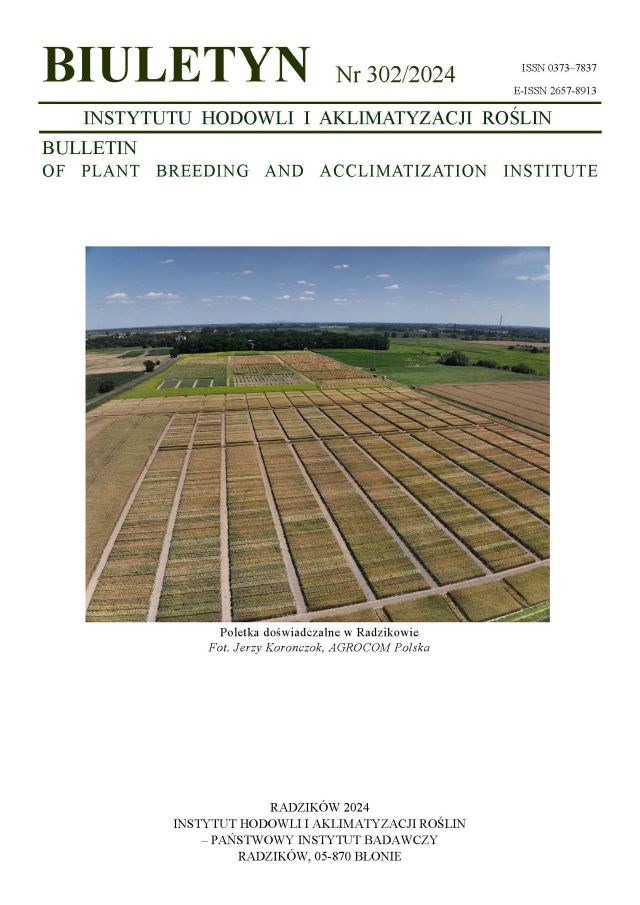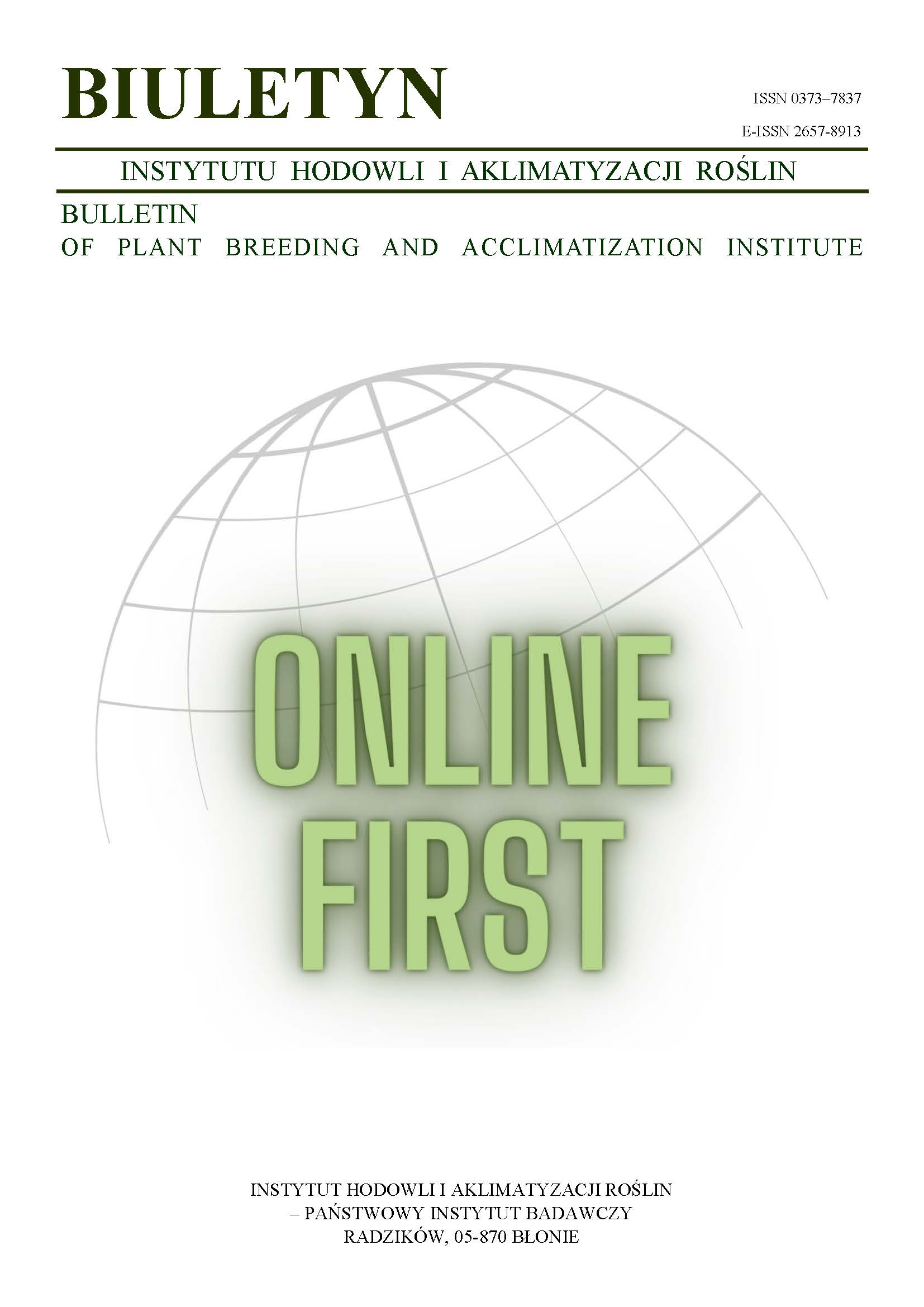Evaluation of breeding value of inbred lines of maize on the basis of multitrait analysis
Henryk Bujak
henryk.bujak@upwr.edu.plKatedra Hodowli Roślin i Nasiennictwa, Akademia Rolnicza we Wrocławiu (Poland)
Stanisław Jedyński
Katedra Hodowli Roślin i Nasiennictwa, Akademia Rolnicza we Wrocławiu (Poland)
Jan Kaczmarek
Katedra Hodowli Roślin i Nasiennictwa, Akademia Rolnicza we Wrocławiu (Poland)
Cecylia Karwowska
Hodowla Roślin Rolniczych „Nasiona Kobierzyc” Sp. z o.o. (Poland)
Zbigniew Kurczych
Hodowla Roślin Rolniczych „Nasiona Kobierzyc” Sp. z o.o. (Poland)
Józef Adamaczyk
Hodowla Roślin Smolice Sp. z o.o. (Poland)
Abstract
Forty eight maize hybrids obtained by crossing of six lines with eight flint testers were sown in a square lattice with two replications at two locations (Kobierzyce, Smolice). Statistical analyses were performed according to the computer program SERGEN. Indices expressing crossing potential were calculated for all lines and testers. Significant GCA effects were estimated for plant height, ear length, no. of rows/ear and no. of seeds/ear. SCA effects were significant for no. of seeds/ear. Significant interaction of maternal GCA effects with environment was found for ear length, no. of seeds/ear and seed weight/ ear whereas GCA effects for testers were significant in the case of ear length, no. of rows/ear and seed weight/ear. Plant height, ear length and no. of rows/ear were mostly determined by additive gene action. Both additive and non-additive gene action was involved in the inheritance of no. of grains/ear. The most promising lines were 1450-9, 1470-8, 1470-12, K 154, K 182 and K 324 which showed high crossing potential. The best hybrids were 1360-5 x K 194 and 1450-9 x K154 which were characterized by high no. of seeds/ear.
Keywords:
combining ability, crossing potential, inbred lines, maizeReferences
Adamczyk J. 2005. Genetyczne podstawy hodowli kukurydzy (Zea mays L.). W: Zarys genetyki zbóż., t. 2, Wyd. Inst. Genetyki Roślin PAN, Poznań.
Google Scholar
Bujak H., Kaczmarek J., Jedyński S., Karwowska C., Kurczych Z., Adamczyk J. 2004. Ocena wartości hodowlanej materiałów wyjściowych kukurydzy (Zea Mays L.) Rozprawy i Monografie Instytutu Genetyki Roślin PAN Poznań 11: 243 — 249.
Google Scholar
Caliński T., Czajka S., Kaczmarek Z., Krajewski P., Siatkowski I., 1998. Podręcznik użytkownika programu Sergen 3. Inst. Genetyki Roślin PAN, Poznań.
Google Scholar
Czajka S. 1996. Metody analizy serii doświadczeń wielokrotnych i wieloletnich zakładanych w układzie o blokach niekompletnych. Listy Biometryczne — Biometrical Letters 32: 101 — 129.
Google Scholar
Kaczmarek J., Bujak H. 1993 a. Analiza genetyczna integralności systemu kilku cech użytkowych żyta z wykorzystaniem asocjacyjnej wartości kombinacyjnej. Biul. Inf. AR-T Olsztyn 34: 165— 177.
Google Scholar
Kaczmarek J., Bujak H. 1993 b. Homeostaza odmian i rodów żyta. Zesz. Nauk. AR Wrocław 223: 101— 103.
Google Scholar
Authors
Henryk Bujakhenryk.bujak@upwr.edu.pl
Katedra Hodowli Roślin i Nasiennictwa, Akademia Rolnicza we Wrocławiu Poland
Authors
Stanisław JedyńskiKatedra Hodowli Roślin i Nasiennictwa, Akademia Rolnicza we Wrocławiu Poland
Authors
Jan KaczmarekKatedra Hodowli Roślin i Nasiennictwa, Akademia Rolnicza we Wrocławiu Poland
Authors
Cecylia KarwowskaHodowla Roślin Rolniczych „Nasiona Kobierzyc” Sp. z o.o. Poland
Authors
Zbigniew KurczychHodowla Roślin Rolniczych „Nasiona Kobierzyc” Sp. z o.o. Poland
Authors
Józef AdamaczykHodowla Roślin Smolice Sp. z o.o. Poland
Statistics
Abstract views: 23PDF downloads: 6
License
Copyright (c) 2006 Henryk Bujak, Stanisław Jedyński, Jan Kaczmarek, Cecylia Karwowska, Zbigniew Kurczych, Józef Adamaczyk

This work is licensed under a Creative Commons Attribution-ShareAlike 4.0 International License.
Upon submitting the article, the Authors grant the Publisher a non-exclusive and free license to use the article for an indefinite period of time throughout the world in the following fields of use:
- Production and reproduction of copies of the article using a specific technique, including printing and digital technology.
- Placing on the market, lending or renting the original or copies of the article.
- Public performance, exhibition, display, reproduction, broadcasting and re-broadcasting, as well as making the article publicly available in such a way that everyone can access it at a place and time of their choice.
- Including the article in a collective work.
- Uploading an article in electronic form to electronic platforms or otherwise introducing an article in electronic form to the Internet or other network.
- Dissemination of the article in electronic form on the Internet or other network, in collective work as well as independently.
- Making the article available in an electronic version in such a way that everyone can access it at a place and time of their choice, in particular via the Internet.
Authors by sending a request for publication:
- They consent to the publication of the article in the journal,
- They agree to give the publication a DOI (Digital Object Identifier),
- They undertake to comply with the publishing house's code of ethics in accordance with the guidelines of the Committee on Publication Ethics (COPE), (http://ihar.edu.pl/biblioteka_i_wydawnictwa.php),
- They consent to the articles being made available in electronic form under the CC BY-SA 4.0 license, in open access,
- They agree to send article metadata to commercial and non-commercial journal indexing databases.
Most read articles by the same author(s)
- Henryk Bujak, Jarosław Nadziak, The effects of different active substances in fungicides on yielding of spring barley cultivars expressing diversified genetic base of resistance to powdery mildew , Bulletin of Plant Breeding and Acclimatization Institute: No. 249 (2008): Regular issue
- Henryk Bujak, Stanisław Jedyński, Jan Kaczmarek, Application of the method of homogeneous group ranks and coefficients of variability to evaluation of yield stability of rye cultivars , Bulletin of Plant Breeding and Acclimatization Institute: No. 250 (2008): Regular issue
- Ryszard Weber, Henryk Bujak, Jan Kaczmarek, Edward Gacek, Analysis of yield variability in winter wheat cultivars in South-Western Poland , Bulletin of Plant Breeding and Acclimatization Institute: No. 260/261 (2011): Regular issue
- Henryk Bujak, Stanisław Jedyński, Jan Kaczmarek, Andrzej Kotecki, Evaluation of yield stability of open-pollinated and hybrid cultivars of winter oilseed rape , Bulletin of Plant Breeding and Acclimatization Institute: No. 250 (2008): Regular issue
- Henryk Bujak, Kamila Nowosad, Agnieszka Łącka, Search for genetic sources to powdery mildew and brown rust resistance in rye inbred lines and varieties collection , Bulletin of Plant Breeding and Acclimatization Institute: No. 286 (2019): Special issue
- Henryk Bujak , Kamila Nowosad , Agnieszka Łącka , Jerzy Nawracała , Agnieszka Tomkowiak , Danuta Kurasiak-Popowska , Dorota Weigt , Evaluation of genetic diversity of inbred maize lines using molecular markers , Bulletin of Plant Breeding and Acclimatization Institute: No. 286 (2019): Special issue
- Andrzej Latusek, Henryk Bujak, Evaluation of yield stability of winter oilseed rape cultivars on the basis of post-registration variety testing system in diversified soils and climatic conditions in Lower Silesia , Bulletin of Plant Breeding and Acclimatization Institute: No. 265 (2012): Regular issue
- Ryszard Weber, Dariusz Zalewski, Jan Kaczmarek, Variability analysis of thousand-grain weight of winter wheat varieties on the post-registration experiments (PDO) in Lower Silesia , Bulletin of Plant Breeding and Acclimatization Institute: No. 253 (2009): Regular issue
- Janusz Rogacki, Zofia Bulińska-Radomska, Jakub Dzienkiewicz, Józef Adamaczyk, Henryk Cygert, Genetic distance among inbred lines of maize and its association with hybrid performance , Bulletin of Plant Breeding and Acclimatization Institute: No. 253 (2009): Regular issue
- Sylwia Lewandowska, Henryk Bujak, Tomasz Mikulski, Martin Frauen, Marcin Puślednik, Twenty years after the first registration of the winter oilseed rape variety of NPZ-Lembke company in Poland , Bulletin of Plant Breeding and Acclimatization Institute: No. 282 (2017): Regular issue














